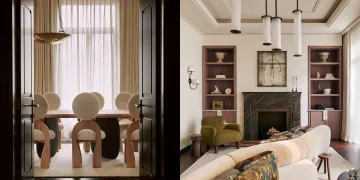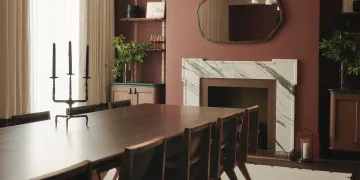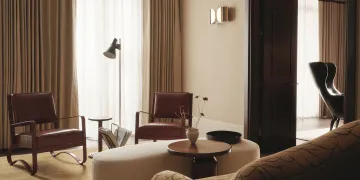Stepping into a space inspired by Georgian interiors is to enter a realm defined by grace, proportion and a sense of enduring calm. This distinguished style emerged in Britain between 1714 and 1837, spanning the reigns of the first four King Georges. It was a period of significant cultural flourishing, deeply influenced by artistic movements from the continent and brought to Britain’s shores by leading architects such as William Kent and Richard Boyle.
The evolution of Georgian-style interior design was shaped by powerful influences, notably the harmonious principles of Palladianism, the intricate whimsy of Rococo, the refined classicism of the Neoclassical era and the lighter elegance of the Regency period. This rich tapestry of inspiration created an aesthetic language that remains profoundly influential in design circles today.
At its core, the Georgian aesthetic drew heavily from the classical architecture of ancient Greece and Rome. The era’s reverence for antiquity instilled a fundamental focus on symmetry, rigorous proportion and a pervasive sense of order. But these philosophical ideals were not merely confined to external facades. They were meticulously woven into the fabric and flow of indoor spaces to reflect a sense of balanced harmony and intellectual clarity. The end result was an atmospheric backdrop that celebrated refinement and understated beauty, avoiding excessive or frivolous ornamentation from the outset.

Georgian-style interior design
The hallmark of classic Georgian-style interior design is a space that feels inherently light and ordered. It possesses a timeless quality that transcends fleeting trends, offering a sense of permanence and considered beauty. Specific architectural elements define this look. For instance, characteristically high ceilings that emphasise space, alongside walls often fitted with elegant panelling or adorned with wallpapers featuring simple, genteel patterns. A palette of soft, muted pastel tones - such as gentle blues, subtle greens and muted pinks - creates a serene and sophisticated atmosphere.
Materials were chosen for their inherent quality and classic appeal. Wood, stone and marble were frequently used for floors, fireplaces and detailing. Furnishings tended to include upholstered chairs and light, graceful drapery that complemented the architectural lines rather than dominating them.
Decorative features, while present, were used with restraint and precision. Ornate cornices, ceiling roses and mouldings added interest. Chandeliers provided focal points and ambient light. Layouts remained strictly symmetrical, reinforcing the overall sense of order. Subtle influences like delicate Chinoiserie motifs and classical architectural details were also incorporated, adding layers of sophistication.
Ultimately, classic Georgian design masterfully creates spaces that feel inherently calm, incredibly refined and deeply comfortable. It is an aesthetic that relies on the power of proportion and the beauty of simplicity, achieving a luxurious feel without the need for excessive or ostentatious ornamentation.

Modern Georgian interior design
Today, discerning designers are expertly adapting the principles of Georgian architecture interior design for contemporary homes, breathing new life into the genre. However, this isn't about creating a pastiche. It's about intelligently reimagining and integrating Georgian styles into modern living spaces.
This approach sees features like elegant wall panelling, gracefully arched doorways and the fundamental principle of classical symmetry used in fresh, updated ways. The goal is to blend historical charm and contemporary comfort in a sophisticated manner, creating homes that respect the past while being perfectly tailored for the 21st century Carolean age.
Think clean-lined, minimalist furniture placed within rooms featuring decorative plasterwork and embellishments, or the application of a muted Georgian colour palette alongside modern textures and innovative lighting solutions. Examples range from minimalist spaces that nonetheless adhere to perfect Georgian proportions to period homes sensitively updated with contemporary fixtures and finishes.
The tone of modern Georgian interior design conveys a deep appreciation for heritage without being constrained by it. It's a style seen in the Grand Townhouses in Chelsea Barracks that feels both elegant and current, demonstrating how the Georgian look can be reimagined to create beautiful, functional spaces for the 21st century homeowner.

Georgian contemporary interior design
Taking the adaptation a step further, Georgian contemporary interior design is about a more explicit blending of classic Georgian house design features with clean aesthetics. This approach is less about updating traditional interiors and more about creating dynamic spaces that deliberately mix elements from both worlds.
This style sees classic Georgian features - like strong symmetry, elegant cornices, prominent fireplaces and large sash windows - paired with modern design choices such as bold, contemporary colours, sleek, minimalist furniture, cutting-edge art and often more open-plan layouts than were traditional.
The aim is to retain the inherent charm, balance and elegant proportions of Georgian style while infusing the space with a fresh, stylish and undeniably current energy. It’s about creating interiors that are comfortable and sophisticated, but also creative and expressive of modern living.
Georgian contemporary interior design shows how tradition and modern living can work together in a harmonious and natural way, resulting in spaces that feel both timeless and entirely of their time, representing a tasteful approach to blending heritage and innovation.
Bringing out the best in your Georgian home
For those fortunate enough to reside in a genuine Georgian house, bringing out the best of its inherent character is a rewarding endeavour. Celebrate and highlight the original architectural features - the majestic fireplaces, the intricate cornices, the delicate plasterwork - allowing them to remain central elements of your design narrative.
Where original features are present but perhaps not at their best, consider expert restoration to breathe new life into them. For elements that may have been lost over time, sourcing period-appropriate details or high-quality reproductions can enhance authenticity and reinforce the home's historical integrity.
Blending this classic architectural backdrop with carefully chosen modern touches creates a thoughtful, layered space. It’s not about creating a museum but a comfortable, lived-in home that feels both profoundly elegant due to its classical undertones and deeply personal through your contemporary expression.
Choosing to live with and enhance Georgian interior design is an appreciation of enduring quality and timeless style. It’s about creating a home that resonates with history while providing all the comforts and aesthetics of modern luxury living.
Sources:
William Kent: designing Georgian Britain
Seven features of a Georgian home
Identifying Georgian, Victorian and Edwardian homes


